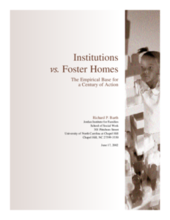The debate about the role of institutional care vs. family-centered care is well into its second century. Institutional (or group) care has many forms and purposes, including serving as a component of the child welfare services system of care and as a treatment component of the children’s mental health systems system of care. Within the child welfare role, institutional care may be used as a large or small shelter care facility, as a place for children to go when family care is not immediately available, and as a place where children go who have not been able to be maintained in foster family care. The varied roles of institutional care make an analysis of its efficacy difficult. This is made more difficult because of the lack of third-party studies of institutional care and, more generally, of out-of-home care.
Placement in group care settings is not an essential component of child welfare services systems of care for the vast majority of children. There is no substantial evidence to support the necessity or value of large centralized emergency shelters or residential treatment centers for most children involved with child welfare services. The costs of these placements are so much higher than other placements, yet their efficacy appears to be no greater. Therefore, their use cannot be justified on a cost-benefit basis if any other levels of care can provide a safe place for children.
©Jordan Institute for Families, University of North Carolina

